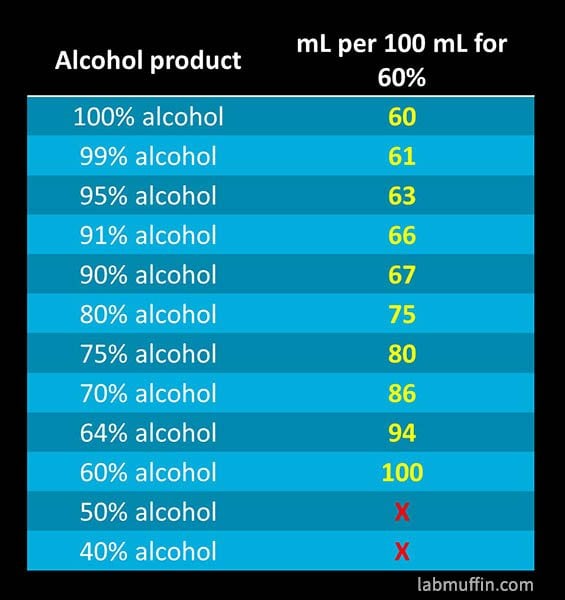Thanks to the COVID-19 pandemic there’s a hand sanitizer shortage… and a ton of DIY hand sanitizer recipes. Will they actually work? (Spoiler: Most of them won’t.)
I’ve made a video breaking down some of the good bad DIY hand sanitizer recipes out there.
Check out the video on YouTube here.
Key points:
COVID-19 is caused by SARS-CoV-2 (novel coronavirus 2019). One of the ways this virus spreads is by getting on your hands, which then touch your eyes, nose and mouth, then the virus can take hold and multiply in your respiratory tract. To prevent this from happening, health authorities have been promoting hand washing for at least 20 seconds with soap and water, and hand sanitisers when you can’t wash your hands.
(Even if you personally aren’t in a high risk group, it’s a good idea to limit transmission to try to flatten the curve, so hospitals won’t get overwhelmed, and reduce the risk of passing it onto someone vulnerable. Plus it’s often not a very pleasant disease to have, even if you don’t get hospitalised.)
The WHO has these recommended hand sanitiser recipes, which are the ones I would use. These consist of high alcohol content, glycerin (to soften hands) and hydrogen peroxide (to kill bacterial spores on equipment – this doesn’t act to kill germs on your hands).
- Hand sanitisers need to contain 60-95% alcohol to reliably inactivate the coronavirus.
- Currently (as of 14 March 2020) other substances aren’t recommended in hand sanitisers (benzalkonium chloride and other cationic detergents are more effective against bacteria than viruses, and there isn’t any data on how well these work against this coronavirus).
- Essential oils aren’t known to work.
To get over 60% alcohol in the final product, you need to have at least 60% of your recipe as alcohol (if you’re using pure alcohol – you’ll need more if it’s less than 100% alcohol).

You’ll also need to be using an alcohol-containing product with at least 60% alcohol content. Witch hazel (15-30% alcohol) and regular drinking alcohol (<40% alcohol) won’t work (unless it’s nasty high alcohol content drinking alcohol – at least 120-proof).
The DIY recipes I’ve found have alcohol contents ranging from 0% to 70% (a lot of them give “options” that can drop the alcohol content below an acceptable level.)
I’ve also made an Alcohol Content Calculator for working out the final alcohol concentration for a recipe. Link is here – it should be pretty self-explanatory.

Some of the recipes I’ve come across show a disturbing lack of comprehension of how hand sanitizers and destroying viruses work. Statements like “this has worked for me for years”, “the CDC says to use 60% alcohol” (proceeds to add a million things to the 60% alcohol), “[random ingredient] is a good substitute if you don’t have alcohol” were frighteningly common. For some reason, these people who couldn’t handle calculating a percentage or spelling “coronavirus” still felt that they were somehow qualified to make up their own pandemic-halting hand sanitizer recipes.
Anyway, my brain is melting from some of the stupid out there. Stay safe, everyone!
Related post: How Bad Is Alcohol in Skincare, Really? The Science






Ive not been able to purchase hand sanitizer for two weeks. I’m not tempted to make my own. Thank you for this article and video.
Thanks Michelle!
I’m just carrying around straight 70% isopropyl alcohol in a spray. When I can wash, I’m using a tube of fancy Aussie petrolatum on wet skin. Seems to keep me from getting too dried.
Because I’m currently in a location that’s very dry and cold, I’m also using the petrolatum around my eyes, lips, and nostrils to keep from getting dry and cracked. Do you know how this either affects or helps protect?
Your face is too ugly and fat. Who wants to see your face like this?
No one care about your money..
It’s a shame that during a time when the world is coming together to help one another, that serpents slither out of the devils clinch to attack people like Michelle who are selflessly contributing to the greater good.
Thank you and God bless you Michelle. The radiance from your inner and outer beauty ‘sanitize’ the toxins that spew from this persons mind.
To the person called “F—- You”…. Why???? We are made in Gods image. What gives you the right to judge? I will pray for you. Remember, you reap what you sow. I pray God blesses you in everything you do.
Thank you Michelle,
Your video and online google calculator were just what I needed to make hand sanitizer. Previously, I watched some other videos on the subject and I downloaded a alcohol dilution app, but your google calculator give me the same results and is easier to use. Thank you for being very thorough. Cheers!
Thank you for guiding us about the Bad hand sanitizing.
I am so happy to have found this video. I love to know the why (to reinforce knowledge) and you did a fantastic job of explaining. The visual aids aids kept me engaged and the examples left little room for “what if’s”.
You went above and beyond with the measurement calculator. My 5 and 7 year old helped me make our first batch of DIY sanitizer and the 7 y/o was easily able to understand how to input the info and adjust to make sure we were making an effective sanitizer. The 5 y/o just wanted to pour 🙂
Again, thank you. Beautiful job!